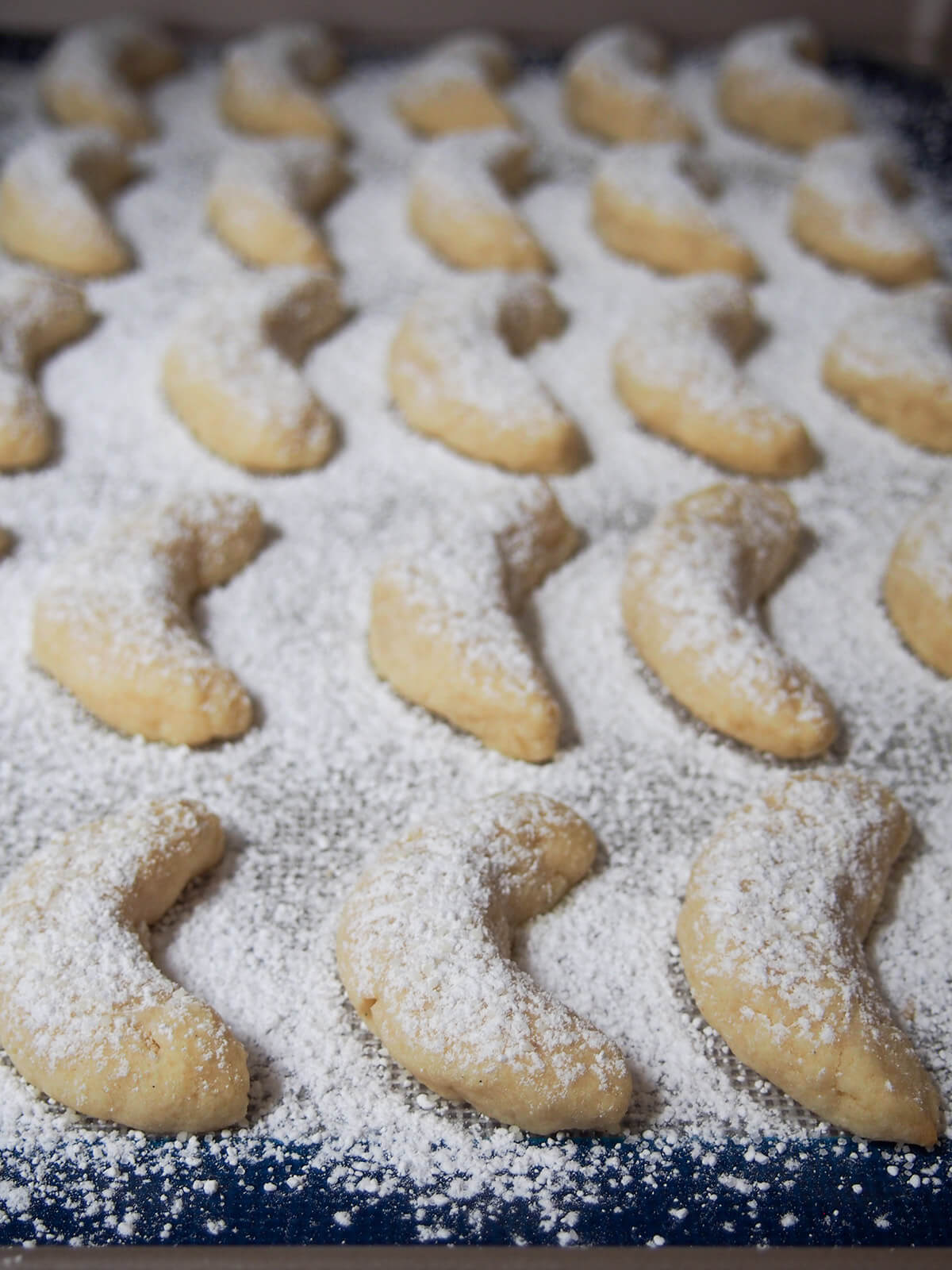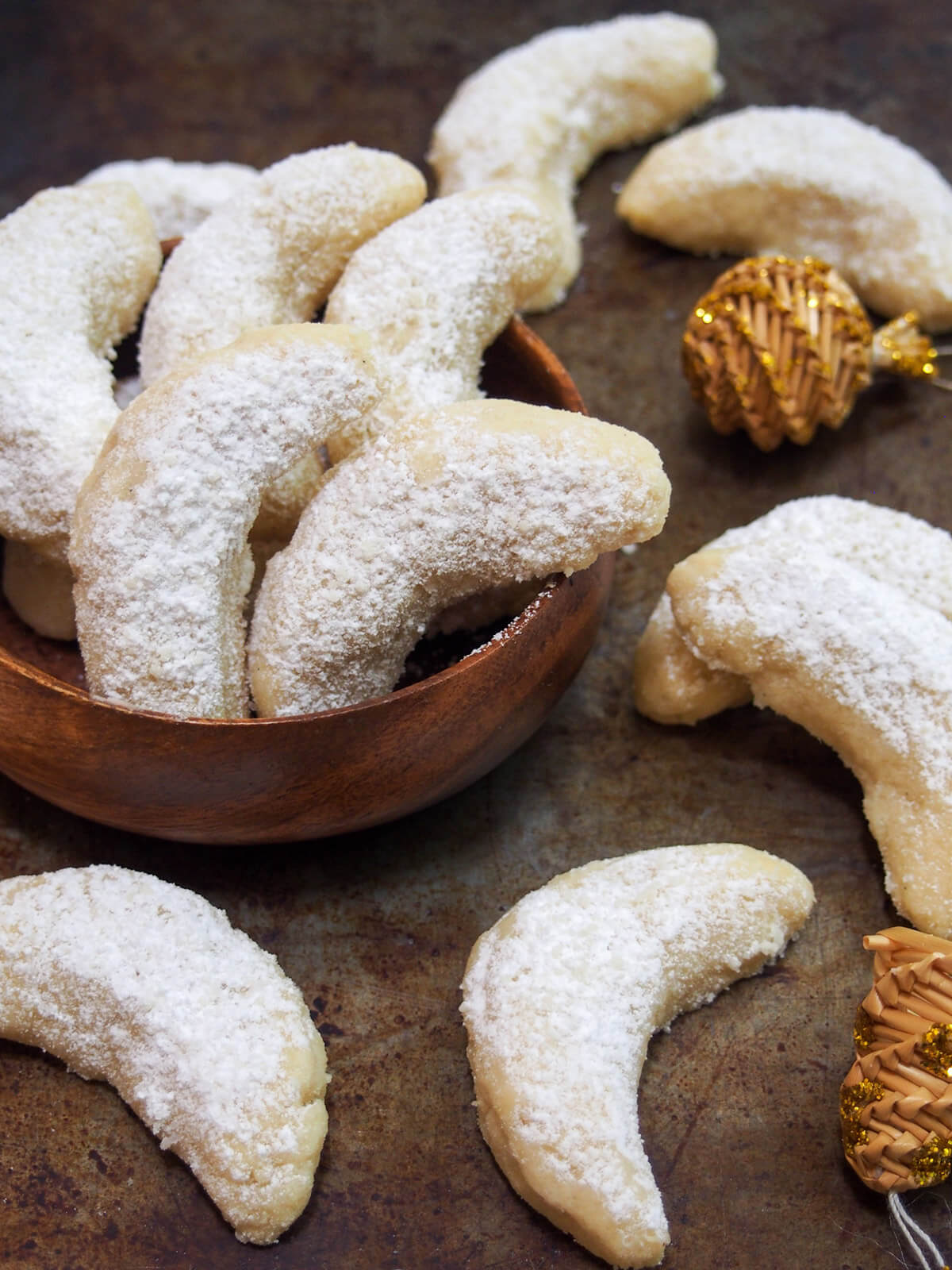Vanillekipferl are a classic Austrian/German cookie with a delicate vanilla flavor. These vanilla crescent cookies melt in your mouth and are a perfect addition to a seasonal cookie plate.

This post may contain affiliate links, where we earn from qualifying purchases. See more details in the policy page.
There are a few countries that have a festive cookie tradition and Germany is most certainly one of them. In fact, I remember when I was a student in Germany many years ago, we had a lesson dedicated to cookie and stollen recipes. Unfortunately it wasn't a tasting lesson, but still gave plenty to whet our appetites.
Thankfully, I have managed to keep the original recipes, even if these days I need a little more help translating. I have shared slight adaptations of a number of them here before, like German ginger cookies and hazelnut cookies. Given how much these vanilla crescents are a classic, it was about time I shared them too.

What are the origins of vanilla crescent cookies?
These cookies apparently originate more from Austria rather than Germany as they were developed during the Austro-Hungarian Empire. The story goes, they were created in the crescent shape to recognize a military win over Turkey. These days, they are popular throughout the region.
The cookies have vanilla both in the dough and in the sugar dusting on the top. There is also a little almond flour in the dough which helps them be nice and soft and have a lovely flavor.

Do you need egg in the dough?
You may find that some recipes use egg in the dough, along with the other ingredients. Egg acts as a binder so helps the dough hold together a little better. Without it, the dough can be a little crumbly.
However, the original German recipe that I use does not include it, nor do many other traditional recipes I have found. While it means the dough is slightly harder to work with, the difference is in taste.
The cookies are more melt-in-your-mouth tender without the egg. Egg can add a little chewiness which fits in some cookies, but less so here. These have more in common with shortbread, which also doesn't use egg and I imagine for much the same reason.
So, while you might have moments getting slightly frustrated with the dough, I believe it's worth skipping the egg.

Making the dough
Some recipes I have seen use powdered sugar and mix all of the ingredients together. The recipe I learnt, though, instead uses regular sugar and creams the butter and sugar together first. This is the same method as I use for my various shortbread recipes.
I'm not sure if there is a huge amount of difference, if any, in the end result, but potentially creaming helps the dough be a little lighter. Either way, once all the ingredients are in, you may find the dough just feels like crumbs.

This is nothing to worry about, you just need to get your hands in there. Use your hands to press the dough together and form it in to a ball. Then, cover the dough and chill it. This rest time and the chilling help it hold together.
You then use the warmth of your hands to soften the dough slightly and form the crescents. Try not to over-work the dough as it will then become too soft. Don't worry if the crescents aren't perfect. They will taste delicious whatever their shape! You can also smooth cracks a little while on the baking sheet before you bake, too.

What is vanilla sugar?
One ingredient in these which may not be familiar is vanilla sugar. It's basically vanilla-infused sugar and adds a lovely aromatic sweetness. You'll easily find it all over Germany as you use it regularly in German baking in particular. It's especially useful for dusting, as here, to add vanilla flavor without it being in liquid form.
You can buy vanilla sugar online as well as make it yourself at home, either by sitting a cut vanilla pod in a jar of sugar and leaving it to infuse, or adding some vanilla extract to sugar, blending them together then letting it dry. If using extract, you want about 1tbsp extract to ½ cup sugar.

Some recipes use vanilla sugar both in the dough and in the sugar to dust. The recipe I learnt instead uses the seeds from a vanilla pod in the cookies which add lovely flecks to the dough. Here I adapted the recipe slightly to use vanilla paste instead. I find this easier to find than pods (as well as being cheaper and lasts longer) but still has those lovely flecks and the flavor is great too.
Dusting the cookies
Part of what makes these cookies stand out, along with the shape, is the sugar dusting. You add the vanilla-scented sugar while the cookies are still warm, so that it sticks to the cookies. Well, more or less - I can't promise you won't get a little messy when you eat them!

You want to give the cookies a minute to cool slightly when they come out the oven so the sugar doesn't immediately melt. Plus, you may want to add a second dusting a minute or two later.
Vanillekipferl are such wonderfully flavored vanilla crescent cookies that are all too easy to eat with their melt-in-your-mouth texture. They might be a little crumbly to make at times, but they are most definitely worth it. Perfect for the festive season or really any excuse.

Try these other tasty cookies:
- Cucidati (Italian fig-filled cookies)
- Persian walnut cookies (nan-e gerdui)
- Basler brunsli (Swiss chocolate almond cookies)
- Zimtsterne (German cinnamon stars)
- Plus get more Holiday recipes in the archives.
Vanillekipferl (vanilla crescent cookies)
Ingredients
For the cookies
- 200 g unsalted butter (7 oz is 1 ¾ sticks)
- 100 g sugar
- 100 g almond flour ground almonds
- 245 g all purpose flour plain flour
- 1 ½ teaspoon vanilla paste or seeds from ½ vanilla pod
For dusting
- 55 g confectioners sugar icing sugar
- 8 g vanilla sugar 1 packet
Instructions
- Cut the butter into chunks. Cream the butter and sugar together either with a stand mixer or hand mixer. You want the mixture to become slightly glossy.
- Add the almond flour, flour and vanilla to the butter mixture and mix well. You can start with mixer or spatula but you will most likely need to finish with your hands to get the dough to come together. Press the dough into a ball and wrap it then refrigerate for 1 - 2 hours.
- Once the dough has chilled, preheat the oven to 375F/190C. Line one or two baking sheets/trays with silicone baking mats or parchment paper.
- Cut a piece of dough from the chilled dough (I usually take around ⅛th) and press it with your fingers to form a log. You can try to roll it, if you prefer, but I find it tends to break if you do. Once the log is around ¾in/2cm thick, cut pieces around 2in/5cm in length. Then gently form each of those lengths into a crescent shape (they will become longer and thinner as you curl it round - you can, alternatively, cut longer thinner lengths). Place each crescent on the prepared baking sheet and smooth any cracks with the side of a knife or back of your fingers. Repeat with the rest of the dough.
- Once you have rolled and formed all of the cookies, bake them for approximately 8 - 10 minutes until they look dry on top but are not quite starting to brown. They will still be soft to touch.
- As the cookies are baking, or before, mix together the confectioner's sugar/icing sugar and vanilla sugar.
- Once the cookies are dry but not browned, remove from the oven and allow to cool for a minute before sprinkling the vanilla confectioner's sugar over the top of them, sprinkling through a small fine strainer so you break up any lumps. Let them cool a few more minutes then sprinkle them with sugar again as some will have melted a little. You can also carefully pick them up and dip the base in some of the excess sugar on the baking sheet.
- Once they have cooled for around 8-10 minutes, transfer them to a cooling rack to finish cooling before transferring to any container for storage (at room temperature). Take care in storing as they are relatively delicate.
Video
Nutrition
Remember to pin for later!




Gina Pace says
The recepie is explained very clearly
and it is easy to follow.
I’ll bake my tryout batch this week and, if successful, I plan to bake more and have the cookies ready for Easter.
Caroline's Cooking says
I'm glad you found it easy to follow - hope they work out well for Easter for you.
Kelsey says
My dough is always too crumbly, but it seems if I work them more the cookies come out tough. Any tips on getting the right dough texture without overworking it?
Caroline's Cooking says
It can be a little tricky, I agree - I suggest it works best if you just work with small pieces at a time, to limit how much you handle each chunk. Then maybe try to stop yourself from working it too much as you form into strips and being happy with it cracking or crumbling a little and then more just press it together as you have it formed into the shape you want. Hopefully that helps!
Ashley says
These are delicious! Thank you for teaching me about a new kind of cookie from a culture different than my own. 🙂
Caroline's Cooking says
Glad you enjoyed, and you're welcome!
Susan B says
My mother was Austrian and Vanillekipferl are our favorite Christmas cookie. My mothers recipe used flour, sugar, butter and ground hazelnuts. After baking we dusted with vanilla sugar.
Caroline's Cooking says
Sounds like wonderful memories! And yes, I know a few cookie recipes from this region can use almonds or hazelnuts relatively interchangeably so I can see it being in some variations of these, too.
Dana Sandonato says
These cookies are wonderfully simple and prove that you don't need to get all fancy and add a million different things to make a good cookie! These will be perfect for my upcoming holiday cookie exchange 🙂
Caroline's Cooking says
Very true - not that many ingredients but so delicious. And they'd be perfect for a cookie exchange!
DEBRA S QVIST says
Hi Caroline, do I use ground almonds or almond Flour?
Caroline's Cooking says
Almond flour is better as it is made with skinless almonds and so is a paler color and smoother texture. Generally, ground almonds or almond meal includes the skins and is courser, though this can vary from country to country. Either way, you are looking for the paler, smoother option.